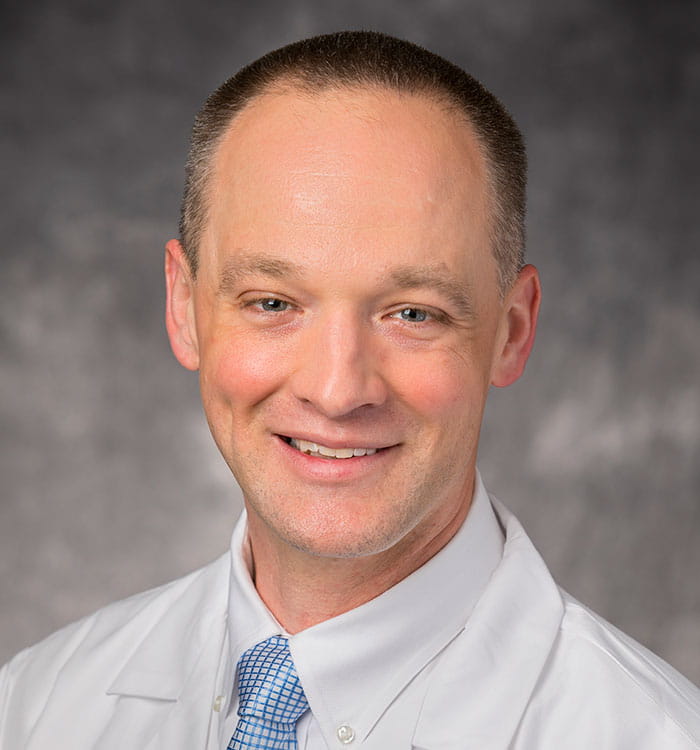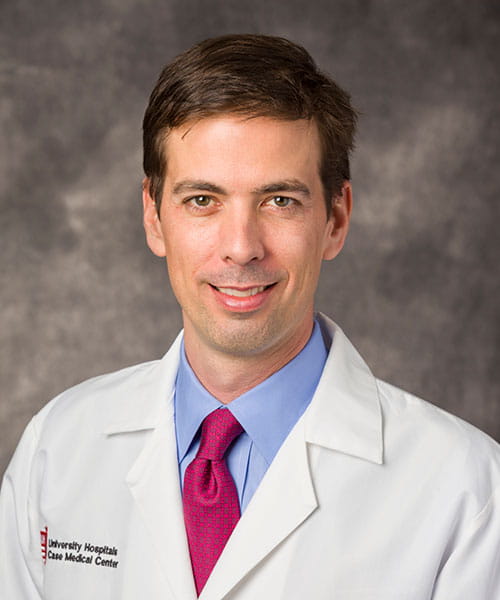UH Team Performs Rare Procedure, Localizes and Removes Lung Cancer for Patient in One Anesthetic Event
August 05, 2025
Innovations in Pulmonology, Critical Care & Sleep Medicine | Summer 2025
A multidisciplinary team at UH Cleveland Medical Center has performed the uncommon procedure of pairing a navigational bronchoscopy and placement of an indocyanine green (ICG) dye-soaked fiducial coil marker with a subsequent robotic wedge resection of the lung, all under a single anesthetic event.
 Benjamin Young, MD
Benjamin Young, MD Christopher Towe, MD
Christopher Towe, MDInterventional pulmonologist Benjamin Young, MD, and thoracic surgeon Christopher Towe, MD, treated a 73-year-old former smoker with a history of large cell neuroendocrine tumor in the left upper lobe and adenocarcinoma in the right lower lobe. She recently presented with a growing lower left lobe nodule, prompting the novel course of treatment.
“The patient’s prior resections created significant pleural adhesions and distorted anatomy, rendering conventional intraoperative localization techniques less reliable,” Dr. Towe says.
To work around this, the team turned to the fluorescence imaging system called Firefly. It allows the thoracic surgeon to localize a non-palpable nodule in a post-lobectomy chest.
“The ICG-soaked coil provided reliable visual fluorescence guidance in the Firefly system,” Dr. Towe says.
In this case, it allowed the surgical team to confidently localize a small lesion obscured by dense adhesions and scarring. This precise guidance reduces the likelihood of incomplete resection, helps preserve healthy tissue, shortens operative time and eliminates the need for an incision to palpate the lung, Dr. Towe says.
This procedure was a first for University Hospitals, says Dr. Young. And, he adds, the outcome was what everyone had hoped it would be.
“This is the first time we've done a single anesthetic event where we go in and mark the nodule for our thoracic surgery colleagues,” he says. “The patient was taken directly from the bronchoscopy suite while they were under anesthesia up to the operating room and then had the surgical procedure. She went home the next day.”
Both Dr. Young and Dr. Towe also point out the safety advantages for the patient of combining two separate procedures into one.
“Combining bronchoscopic fiducial placement and robotic resection minimized the number of anesthetic events and reduced cumulative procedural risk compared to staging these interventions separately,” Dr. Towe says.
Since this first case, the UH team has done a handful of others, with plans for future growth.
“Looking forward, the goal is to expand the use of combined navigational bronchoscopy and robotic resection or other localization techniques to a broader cohort of patients who would benefit from precise, efficient treatment,” Dr. Towe says.
Ideal candidates include:
- Patients with small or subsolid pulmonary nodules that are difficult to localize intraoperatively.
- Individuals with prior thoracic surgeries or significant pleural adhesions that obscure conventional visual or tactile identification.
- Those who are clinically fit for a single anesthetic event but in whom staged procedures would increase cumulative risk or delay definitive treatment.
“The ‘one-stop’ workflow—performing localization and resection in a single setting—has the potential to improve accuracy, reduce operative time and streamline care delivery,” Dr. Towe says. “This approach may shorten the interval from diagnosis to curative treatment, which is particularly important in thoracic oncology. The intent is to integrate these techniques more routinely to enhance both clinical outcomes and patient experience. This case serves as proof of concept for combining advanced interventional pulmonology and robotic thoracic surgery to address complex surgical scenarios.”
For now, it’s clear that this case sets the UH team apart.
“The concurrent use of navigational bronchoscopic marking with intraoperative fluorescence imaging to localize a non-palpable nodule in a post-lobectomy chest demonstrates a workflow and technological capability that is available only in select centers with both advanced interventional pulmonology and robotic thoracic surgery infrastructure,” Dr. Towe says. “This positions University Hospitals ahead of many peer institutions in offering a streamlined, minimally invasive approach for patients with complex operative histories and anatomically challenging lesions.”
Contributing Experts:
Benjamin Young, MD
Interventional Pulmonologist
Medical Director, Bronchoscopy
UH Cleveland Medical Center
Assistant Professor of Medicine
Case Western Reserve University School of Medicine
Christopher Towe, MD
Thoracic Surgeon
UH Cleveland Medical Center
Clinical Assistant Professor of Surgery
Case Western Reserve University School of Medicine


